| Author |
Message |
|
Gajdos Peter
Location: Hungary Joined: 12 Jan 2015
Posts: 9
|
 Posted: Mon 12 Jan, 2015 10:36 am Post subject: Rare 13-14th century medieval sword !? Posted: Mon 12 Jan, 2015 10:36 am Post subject: Rare 13-14th century medieval sword !? |
 |
|
Hello All,
I recently acquired this sword with a rare type of N pommel with another one with a type j pommel, but this seems to be more interesting to me.
It came from the U.S. , from a woman who knew nothing about it realy, she said it is a 16th century german dagger, guess it was one of her relative's stuff or was given to her to sell, or who knows.
I could not find too much information, it seems to be authentic, although I have little knowledge about these sword since I collect japanese swords mainly. Not sure why would anyone fake a sword with a rare type of pommel anyway, on the edge I can see small lose laminations, folding layers, it is covered with some thick preservation wax but still easily watchable for details.
Cutting edge is 74cm, full sword length is 88cm
Can anyone tell anything about this sword or where should I inquire further?
If someone in interested in the other sword I am happy to take pictures and upload them.
 Attachment: 48.24 KB Attachment: 48.24 KB
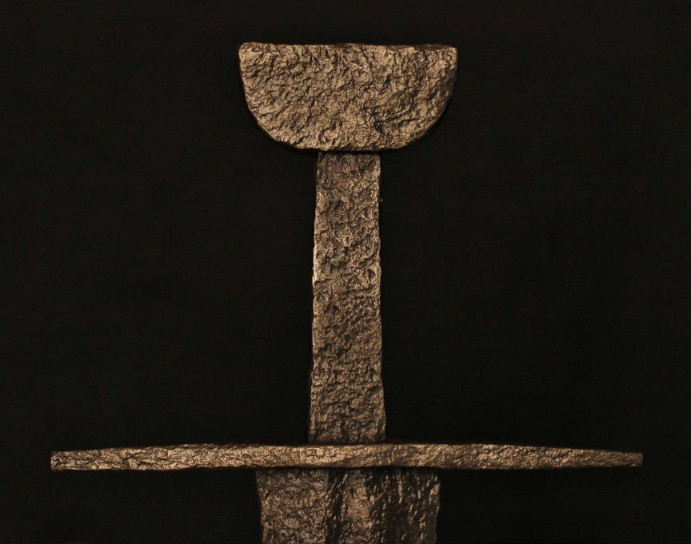
 Attachment: 25.28 KB Attachment: 25.28 KB
[ Download ]
 Attachment: 28.34 KB Attachment: 28.34 KB
[ Download ]
 Attachment: 60.97 KB Attachment: 60.97 KB
[ Download ]
 Attachment: 43.72 KB Attachment: 43.72 KB
[ Download ]
 Attachment: 67.37 KB Attachment: 67.37 KB
[ Download ]
 Attachment: 66.78 KB Attachment: 66.78 KB
[ Download ]
 Attachment: 69.56 KB Attachment: 69.56 KB
[ Download ]
 Attachment: 104.53 KB Attachment: 104.53 KB
[ Download ]
 Attachment: 104.96 KB Attachment: 104.96 KB
[ Download ]
|
|
   |
 |
Luka Borscak

|
 Posted: Mon 12 Jan, 2015 12:27 pm Post subject: Posted: Mon 12 Jan, 2015 12:27 pm Post subject: |
 |
|
|
The corrosion looks old, at least to me, but the sword is a bit suspicious to me. The blade tapers very dramatically for a sword of that type, the tang doesn't taper at all, the pommel is crude and a bit too big and thick, proportions are a bit weird... I don't know. Could be real, but I would suspect it's a 19th century or even later replica... But I would gladly be proved wrong...
|
|
  |
 |
|
Mart Shearer
|
 Posted: Mon 12 Jan, 2015 12:35 pm Post subject: Re: Rare 13-14th century medieval sword !? Posted: Mon 12 Jan, 2015 12:35 pm Post subject: Re: Rare 13-14th century medieval sword !? |
 |
|
| Gajdos Peter wrote: | | Not sure why would anyone fake a sword with a rare type of pommel anyway, ..... |
Because rare items fetch a higher price than common ones?
ferrum ferro acuitur et homo exacuit faciem amici sui
|
|
  |
 |
|
Gajdos Peter
Location: Hungary Joined: 12 Jan 2015
Posts: 9
|
 Posted: Tue 13 Jan, 2015 12:05 am Post subject: Posted: Tue 13 Jan, 2015 12:05 am Post subject: |
 |
|
Hello,
thanks for the replies,
the tang has a small tapering, around 1.5cm long from the cross bar eniding in a round point, it is hard to see but easy to fell and then notice it. About the pommel, I seen much cruder works than this, about size , this type and similar sized type pommels are this big, the balance is good for the sword so the size was done for a reason.
Victorian copies are having like a dark brown dried oil like patination, not a worn surgace as it was in the ground or river, it had a twist and small bend that had to be realigned by a restorer. If it was a copy of a rare type pommel they would copy exactly the same dimensions and would make it longer as long ones are more desirable.
I am not saying it is not a copy but feel your reasoning are not convincing enough and since I can see this blade has layers, forged, flexible, has age apropriate patination and wear, so I still have not decided what to believe yet.
regards
Peter G.
|
|
   |
 |
|
Gajdos Peter
Location: Hungary Joined: 12 Jan 2015
Posts: 9
|
 Posted: Tue 13 Jan, 2015 12:34 am Post subject: Posted: Tue 13 Jan, 2015 12:34 am Post subject: |
 |
|
In my research I found only 2 sword with online pictures that is similar to mine, although from this type there is about 10-12 swords excavated (all example came from ground) only these are pictured on the net. All was found after the Victorian period as far I know. You may notice they has same short tang with very little tapering and large pommel on both excavated swords, found as shown on the map. I am not saying it is genuine but it has a chance and it could be worthy to authenticate it as it would be even historicaly important if turned out to be genuine.
 Attachment: 11.56 KB Attachment: 11.56 KB
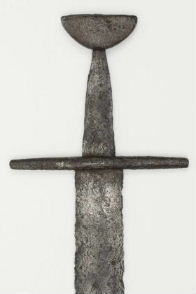
 Attachment: 10.09 KB Attachment: 10.09 KB

 Attachment: 15.89 KB Attachment: 15.89 KB

 Attachment: 97.12 KB Attachment: 97.12 KB
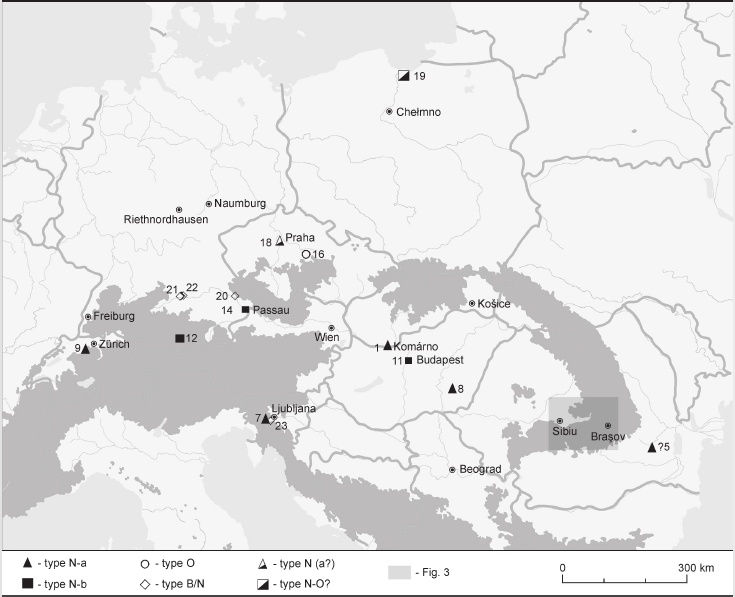
 Attachment: 90.91 KB Attachment: 90.91 KB
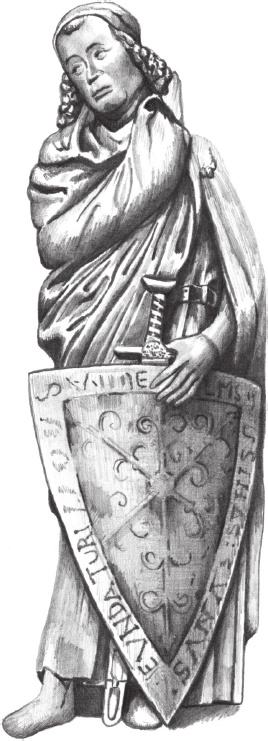
|
|
   |
 |
|
Mart Shearer
|
 Posted: Tue 13 Jan, 2015 12:44 am Post subject: Posted: Tue 13 Jan, 2015 12:44 am Post subject: |
 |
|
Here's a better view of the example from Naumburg Cathedral founder statue of Count Dietmar von Selbold.


ferrum ferro acuitur et homo exacuit faciem amici sui
|
|
  |
 |
|
Gajdos Peter
Location: Hungary Joined: 12 Jan 2015
Posts: 9
|
 Posted: Tue 13 Jan, 2015 12:48 am Post subject: pictures Posted: Tue 13 Jan, 2015 12:48 am Post subject: pictures |
 |
|
|
Great pictures, thank you !
|
|
   |
 |
Luka Borscak

|
 Posted: Tue 13 Jan, 2015 2:26 am Post subject: Posted: Tue 13 Jan, 2015 2:26 am Post subject: |
 |
|
| Gajdos Peter wrote: | Hello,
thanks for the replies,
the tang has a small tapering, around 1.5cm long from the cross bar eniding in a round point, it is hard to see but easy to fell and then notice it. About the pommel, I seen much cruder works than this, about size , this type and similar sized type pommels are this big, the balance is good for the sword so the size was done for a reason.
Victorian copies are having like a dark brown dried oil like patination, not a worn surgace as it was in the ground or river, it had a twist and small bend that had to be realigned by a restorer. If it was a copy of a rare type pommel they would copy exactly the same dimensions and would make it longer as long ones are more desirable.
I am not saying it is not a copy but feel your reasoning are not convincing enough and since I can see this blade has layers, forged, flexible, has age apropriate patination and wear, so I still have not decided what to believe yet.
regards
Peter G. |
Since you have the sword in hand you can definitely see and feel important details we can not. My reasons are definitely not decisive, it was just a few details I found suspicious.
|
|
  |
 |
J.D. Crawford

|
 Posted: Tue 13 Jan, 2015 8:33 pm Post subject: Posted: Tue 13 Jan, 2015 8:33 pm Post subject: |
 |
|
What you need is a professional opinion, but here is another amateur opinion.
First, if this is an authentic sword it would be classified in Oakeshott's scheme as an XIV dating to approximately 1300, give or take. The tip of the sword shows signs of a diamond-shaped cross section which is common to some of those (as well as many cheap modern replicas). On this, Oakeshott commented that this might make it technically an XVI, but he went with the overall shape in classifying such swords as XIV. The fuller looks reasonable to me for this type. The other swords you picture are earlier types: Xa, XI.
Regarding the pommel, in profile it looks like some of the N variants you picture, but I believe this type by definition has a roof-like top and I think that is true of the examples you show. Your sword has a flat top, even swelling in thickness. That puts it closer to an even rarer type 'P', similar to the Naumburg sculpture, which dates a bit earlier to the standard range for XIV but has similar dimensions. So this is either a fake by someone who only knew the profile of N, or a more rare type.
The cross is interesting because of the slight curve. One sees this sometimes in originals, but very rarely in modern replicas - they tend to be straight or clearly curved. I don't know why, but this adds a touch of authenticity.
The tang, again, is the troubling part. As noted above, it is unusually parallel in profile and its chunky thickness. Some XIVs have pretty parallel robust tangs, but then those ones (that I know of) also had the fuller extending well into the tang. This unusual tang, plus the unusual pommel, give the sword its suspicious look. But unusual does not mean wrong: lots of medieval swords have unusual features that don't fit with expected typologies.
I don't see anything obviously wrong with the state of corrosion, although apparently anything can be faked these days.
Overall, just based on those features and intuition, this looks like a real sword to me, but with some unusual features that require more scrutiny for confirmation by a professional.
|
|
   |
 |
|
Mart Shearer
|
 Posted: Tue 13 Jan, 2015 9:09 pm Post subject: Posted: Tue 13 Jan, 2015 9:09 pm Post subject: |
 |
|
| J.D. Crawford wrote: | | Regarding the pommel, in profile it looks like some of the N variants you picture, but I believe this type by definition has a roof-like top and I think that is true of the examples you show. Your sword has a flat top, even swelling in thickness. That puts it closer to an even rarer type 'P', similar to the Naumburg sculpture, which dates a bit earlier to the standard range for XIV but has similar dimensions. So this is either a fake by someone who only knew the profile of N, or a more rare type. |
The Naumberg founder statue of Wilhelm of which Gajdos has given a sketch has that top pent-roof structure
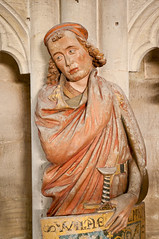
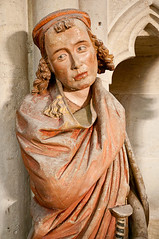
http://www.flickr.com/photos/12575591@N00/5881912621
The myArmoury page says the Type P is only known in a statue from Nuremberg cathedral. Was there confusion between Naumburg and Nuremberg, or is there another statue in Nuremberg which gives another example of the type?
ferrum ferro acuitur et homo exacuit faciem amici sui
|
|
  |
 |
|
Mike Ruhala
Location: Stuart, Florida Joined: 24 Jul 2011
Posts: 335
|
 Posted: Tue 13 Jan, 2015 9:12 pm Post subject: Posted: Tue 13 Jan, 2015 9:12 pm Post subject: |
 |
|
I'd call it an early XVI, XIV's generally have more strongly curved guards and the diamond section at the point helps confirm that IMO. A chunky tang can move more of the sword's overall weight into the hand which can improve handling, in this case that's probably counteracted somewhat by the seemingly largish pommel but Gadjos said it felt well balanced so perhaps it's just right for what it is. Overall it looks plausible to me.
Gadjos, any chance we can have an edge-on pic of the whole sword so we can see the distal taper?
Where is the point of balance at?
|
|
  |
 |
|
Gajdos Peter
Location: Hungary Joined: 12 Jan 2015
Posts: 9
|
 Posted: Tue 13 Jan, 2015 11:53 pm Post subject: more pictures Posted: Tue 13 Jan, 2015 11:53 pm Post subject: more pictures |
 |
|
Thank you for all the replies,
I will upload more pictures from the edge, there is a size limit but hopefuly the pictures are good enough, tried my best.
The balance point is about 5.6 inch from the cross bar, it is between the average 3-6 inch limit and I guess this is why the pommel and tang is so sturdy, otherwise the balance point would be higher up on the blade making it point heavy.
The tang starts with 2.6 cm width but at the pommel it is 2.1cm, so narrows down 5mm, so it is not completely parallel, but you are right, as far I can seen all european swords of this type has some differences and I think there is even more pommel type then noted down, since some only portrayed on statues or paintings and they noted ones have many varieties as well, of course this is my own mind.
"In japanese swords a certain age has a notable characteristic but they all differ and easily notable for an experienced eye, many many varieties, so many features that has many combinations, this is why an unsigned blade van be easily identified which smith family, which style, what province it was made in, and in most cases even the certain smith can be pinpointed out (and there were thousands), the cutting edge was also often measured to the warrior's dimensions or altered down, this is why the tang has more tang holes, due to multiple alterations."
On the pictures you can see that several layers are on each other, on the tip I noticed 2 small lose outside crack, in the middle and on the left side, I often see this in case of old japanese swords but not sure if it is the same thing, I am only knowledgable in japanese blades, not european but there are still similarities.
 Attachment: 32.36 KB Attachment: 32.36 KB
[ Download ]
 Attachment: 32.64 KB Attachment: 32.64 KB
[ Download ]
 Attachment: 32.12 KB Attachment: 32.12 KB
[ Download ]
 Attachment: 34.46 KB Attachment: 34.46 KB
[ Download ]
 Attachment: 74.75 KB Attachment: 74.75 KB
[ Download ]
 Attachment: 90.84 KB Attachment: 90.84 KB
[ Download ]
 Attachment: 101.01 KB Attachment: 101.01 KB
[ Download ]
 Attachment: 65.95 KB Attachment: 65.95 KB
[ Download ]
 Attachment: 87.31 KB Attachment: 87.31 KB
[ Download ]
 Attachment: 59.33 KB Attachment: 59.33 KB
[ Download ]
|
|
   |
 |
|
Gajdos Peter
Location: Hungary Joined: 12 Jan 2015
Posts: 9
|
 Posted: Tue 13 Jan, 2015 11:57 pm Post subject: Posted: Tue 13 Jan, 2015 11:57 pm Post subject: |
 |
|
some more pictures...
By the way, would it help if I post pictures of the other sword I have from the same source?
Since than I noticed the lady sold some other swords and daggers from the 18th century up to ww2, they all seem genuine, I think it was a good collection and even if my swords are turn out to be fakes they deceived the previous collector as well.
 Attachment: 101.04 KB Attachment: 101.04 KB
[ Download ]
 Attachment: 99.23 KB Attachment: 99.23 KB
[ Download ]
 Attachment: 98.01 KB Attachment: 98.01 KB
[ Download ]
 Attachment: 154.11 KB Attachment: 154.11 KB
[ Download ]
|
|
   |
 |
Kai Lawson

|
 Posted: Wed 14 Jan, 2015 10:46 am Post subject: Posted: Wed 14 Jan, 2015 10:46 am Post subject: |
 |
|
It may be an effect of corrosion, but the pommel looks as though it thickens near the top, or each of the large faces bears some slight overall concavity. It also appears that the 'corners' of the pommel may have been slightly higher than the top face, which would be interesting, if real. The tip portion of the blade looks oddly truncated or foreshortened to me, and the sheen on the overall patina also strikes me as a bit odd. That said, both the pommel and cross bear seem to bear some striking similarities to the carved counterparts in the posts above. Does the cross move? Can the blade shoulders be inspected at all?
"And they crossed swords."
--William Goldman, alias S. Morgenstern
|
|
  |
 |
J.D. Crawford

|
 Posted: Wed 14 Jan, 2015 11:20 am Post subject: Posted: Wed 14 Jan, 2015 11:20 am Post subject: |
 |
|
| Mart Shearer wrote: | | J.D. Crawford wrote: | | Regarding the pommel, in profile it looks like some of the N variants you picture, but I believe this type by definition has a roof-like top and I think that is true of the examples you show. Your sword has a flat top, even swelling in thickness. That puts it closer to an even rarer type 'P', similar to the Naumburg sculpture, which dates a bit earlier to the standard range for XIV but has similar dimensions. So this is either a fake by someone who only knew the profile of N, or a more rare type. |
The Naumberg founder statue of Wilhelm of which Gajdos has given a sketch has that top pent-roof structure
|
That one definitely falls in the 'N' family. The one that resembles the current sword goes with Count Dietmar von Selbold as shown above. Isn't that at Naumburg as well?
|
|
   |
 |
|
Gajdos Peter
Location: Hungary Joined: 12 Jan 2015
Posts: 9
|
 Posted: Wed 14 Jan, 2015 12:28 pm Post subject: Posted: Wed 14 Jan, 2015 12:28 pm Post subject: |
 |
|
| Kai Lawson wrote: | | It may be an effect of corrosion, but the pommel looks as though it thickens near the top, or each of the large faces bears some slight overall concavity. It also appears that the 'corners' of the pommel may have been slightly higher than the top face, which would be interesting, if real. The tip portion of the blade looks oddly truncated or foreshortened to me, and the sheen on the overall patina also strikes me as a bit odd. That said, both the pommel and cross bear seem to bear some striking similarities to the carved counterparts in the posts above. Does the cross move? Can the blade shoulders be inspected at all? |
The sword is covered with some kind of wax that gives its shiny look, I guess it is some kind or preservation wax, there is a small ding on the tip with about 1-2mm folding back at the very end, I guess this is the weakest point and easier corroded but I see no alteration there. Yes, it does seem the corners are a bit higher then the rest of the top of the pommel, and the pommel gets thicker going upward. The cross bar does not move.
|
|
   |
 |
|
Mart Shearer
|
 Posted: Wed 14 Jan, 2015 2:06 pm Post subject: Posted: Wed 14 Jan, 2015 2:06 pm Post subject: |
 |
|
| J.D. Crawford wrote: | | Mart Shearer wrote: | | J.D. Crawford wrote: | | Regarding the pommel, in profile it looks like some of the N variants you picture, but I believe this type by definition has a roof-like top and I think that is true of the examples you show. Your sword has a flat top, even swelling in thickness. That puts it closer to an even rarer type 'P', similar to the Naumburg sculpture, which dates a bit earlier to the standard range for XIV but has similar dimensions. So this is either a fake by someone who only knew the profile of N, or a more rare type. |
The Naumberg founder statue of Wilhelm of which Gajdos has given a sketch has that top pent-roof structure
|
That one definitely falls in the 'N' family. The one that resembles the current sword goes with Count Dietmar von Selbold as shown above. Isn't that at Naumburg as well? |
Yes, at Naumburg along with the more famous Ekkehard and Uta. These are the donor figures, or in German the Naumburg Dom stifterfiguren, if that eases your Google searches.
Does anyone have a picture of the supposed Nuremberg Cathedral example, or is the presumption that Naumburg is the sole archetype for the Type P?
ferrum ferro acuitur et homo exacuit faciem amici sui
|
|
  |
 |
|
Gajdos Peter
Location: Hungary Joined: 12 Jan 2015
Posts: 9
|
 Posted: Thu 15 Jan, 2015 2:44 am Post subject: Bonhams interested... Posted: Thu 15 Jan, 2015 2:44 am Post subject: Bonhams interested... |
 |
|
I sent some pictures to Bonhams auctioneers in Enlgand a couple of days ago and they contacted me that they would be interested in the sword and valued it at minimum of 3000 pounds but I have to send it to them so their expert can take a look at it.
I think it is a good opportunity to validate this sword for once and for all, I am going to send it along with the second sword also, but first I need to get the export licence for it. I will let you guys know how it turns out, but I think if it is genuine because of the rare type of pommel it should be worth more and historicaly important in the evolvement of medieval european swords.
|
|
   |
 |
Jussi Ekholm

|
 Posted: Thu 15 Jan, 2015 7:41 am Post subject: Posted: Thu 15 Jan, 2015 7:41 am Post subject: |
 |
|
I would rather contact Hungarian National Museum. You probably have other museums in Hungary too, much less riskier than sending a sword to UK. You could probably be present when an expert is studying the sword and discuss it in person with him.
Jussi Ekholm
|
|
  |
 |
|
Gajdos Peter
Location: Hungary Joined: 12 Jan 2015
Posts: 9
|
 Posted: Thu 15 Jan, 2015 8:15 am Post subject: Posted: Thu 15 Jan, 2015 8:15 am Post subject: |
 |
|
| Jussi Ekholm wrote: | | I would rather contact Hungarian National Museum. You probably have other museums in Hungary too, much less riskier than sending a sword to UK. You could probably be present when an expert is studying the sword and discuss it in person with him. |
I will take it to Budapest, up to the Citadell where the cultural export licence is given out for the 2 swords, it is together with the Citadell museum, so hopefuly I can ask them to take an expert look at them, not just giving out the licence which is basicaly a registration and check if it is not stolen or count as a very important national treasure and therefore not allowed to leave the country.
As far local museums never replied to my requests.
|
|
   |
 |
|
|
You cannot post new topics in this forum
You cannot reply to topics in this forum
You cannot edit your posts in this forum
You cannot delete your posts in this forum
You cannot vote in polls in this forum
You cannot attach files in this forum
You can download files in this forum
|
All contents © Copyright 2003-2025 myArmoury.com — All rights reserved
Discussion forums powered by phpBB © The phpBB Group
Switch to the Basic Low-bandwidth Version of the forum
|

